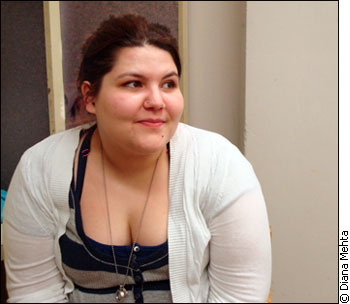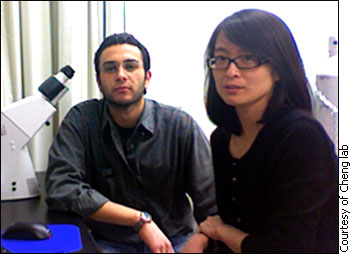 |
| Brittni Laframboise has an internal
clock that can't keep time. |
But Laframboise's lack of shut-eye isn't because she's been
staying out too late. Her biological clock has been ticking
out of sync for the past six years.
"I get tired but still don't fall asleep," she
says. "It's extremely frustrating."
Even a slight change in her routine can throw her internal
clock off track. Falling asleep at 6 a.m. to wake up at 3
p.m. is not out of the ordinary, says Laframboise.
After trying therapy, sleeping pills, natural supplements
and relaxation techniques, she says it's still very hard
for her body to follow a regular schedule.
Laframboise is exactly the kind of person researcher Mary
Cheng is trying to help.
Cheng, a neuroscientist and professor at the University
of Ottawa, is figuring out how the mammalian clock works.
More specifically, she is trying to show how a few short
strands of tiny molecules in the brain influence the speed
at which the internal clock reacts to light. And light, says
Cheng, can reset the biological clock.
"By understanding what's going on, we can look at more
effective treatments for those with screwed up biological
clocks," she says, adding she plans to publish the results
of her work this summer.
It is known that most mammals have a set of regular circadian
rhythms or daily cycles of activity, but how these occur
at a cellular level is not clear.
"I'd like to know how the clock ticks and I'd like
to figure out the genes that make it tick," says Cheng.
Mapping the genetics
The equivalent of a swinging pendulum in our brain is its
master timekeeping centre, the suprachiasmatic nucleus (SCN).
Thirty-four-year-old Cheng is zeroing in on microRNA present
in the SCN which influence the genes that help our bodies
keep time.
By exploring how these strands instruct genes in the body's
clock, Cheng says she is laying the groundwork to help scientists
and eventually clinicians better understand and treat problems
related to biological time.
"It's not only cool to know how the molecules are working,
it actually has some clinical relevance," she says. "It's
going to help a lot of scientists down the road."
Cheng employs genetically modified mice with magnified
versions of the microRNA being studied, to conduct her experiments.
 |
| Mary Cheng (right) and her graduate
student, Matias Alvarez-Saavedra, are trying to understand what makes us tick. |
She has found the genes the light-related microRNAs target
to bring about behavioral changes as the body goes through
its daily rhythms.
"We're really trying to go from genes to behavior and
everything else in between," says Cheng.
Aziz Sancar is an example of someone who could use Cheng's
results in his own work.
Sancar, a biochemist and professor at the North Carolina
School of Medicine, studies the circadian rhythmns of cancerous
cells in mice.
His most recent work found that the ability of DNA repair
differs greatly between day and night. Consequently, chemotherapy
can be more effective if conducted when the ability of a
cancer cell to repair itself is at its lowest in the body's
time cycle, says Sancar.
But, not enough is known yet about the mechanics of mammalian
clocks, he says.
"We know we have to sync our functions with the daily
light-dark cycle, but how do we do it?" asks Sancar. "What
is the molecular mechanism that makes a 24 hour cycle?"
Until recently, chronotherapy-treatment administered at
specific times in a body's 24 hour cycle-had not been taken
serious by the medical community, he says.
Mapping the genetic components which control the mammalian
clock is giving scientists new ways to link research with
clinical use, says Sancar.
Blending science with medicine
Therapists working with patients complaining of irregular
sleep-wake patterns keep an eye out for work which sheds
light on the biological clock, says Wendy-Lee Caldwell, a
therapist and sleep counselor.
Caldwell, who has run her own counseling centre in Ottawa
for 17 years, says chronobiology is still a relatively young
field of study.
"I built all my programs based on research," she
says of the treatment options she offers her patients. "I'm
constantly reading up on new material."
According to Caldwell, studies on biological clocks have
grown in number and depth over the past four years, creating
more options for clinicians.
"Before the research was just baseline," she says. "Now
we've got more foundational research to substantiate the
things we've basically expected."
As Cheng returns to her mice, and Caldwell recommends new
forms of chronotherapy, Laframboise shops around for another
short-term remedy which might ease her sleepless nights.
Talk of Cheng's research makes her sit up straighter. She
says she would volunteer as a test subject when the research
graduates to clinical experimentation, even though that might
not be for a few years.
"All this takes a toll mentally and physically," she
says. "I'm willing to try anything."
Front page courtesy of Anti Aging Treatments
|

